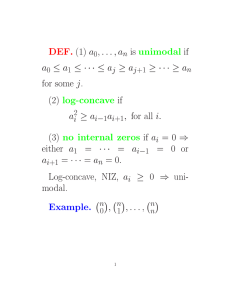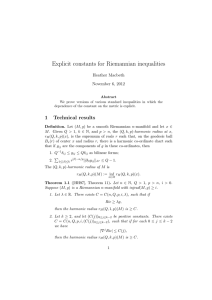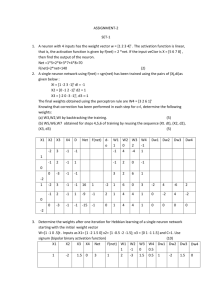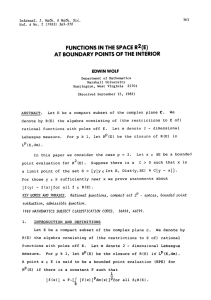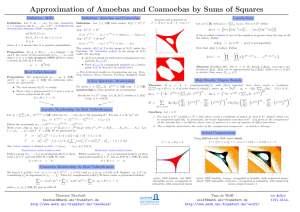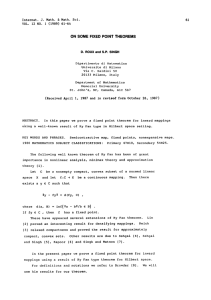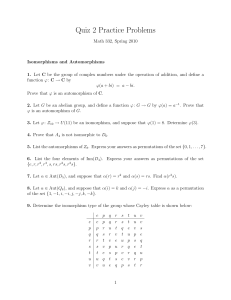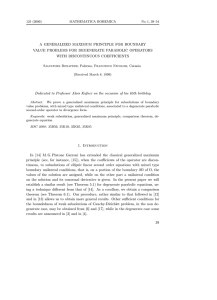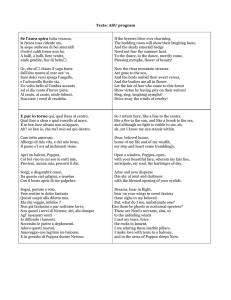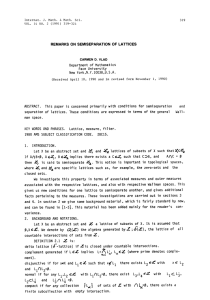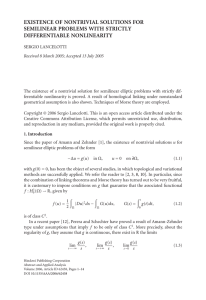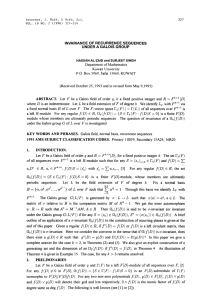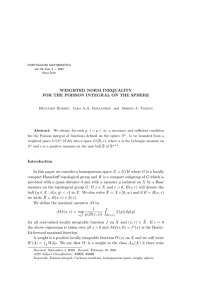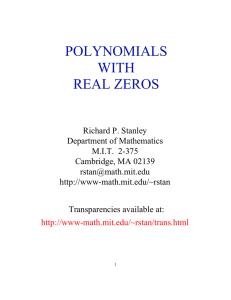Document 10441568
advertisement
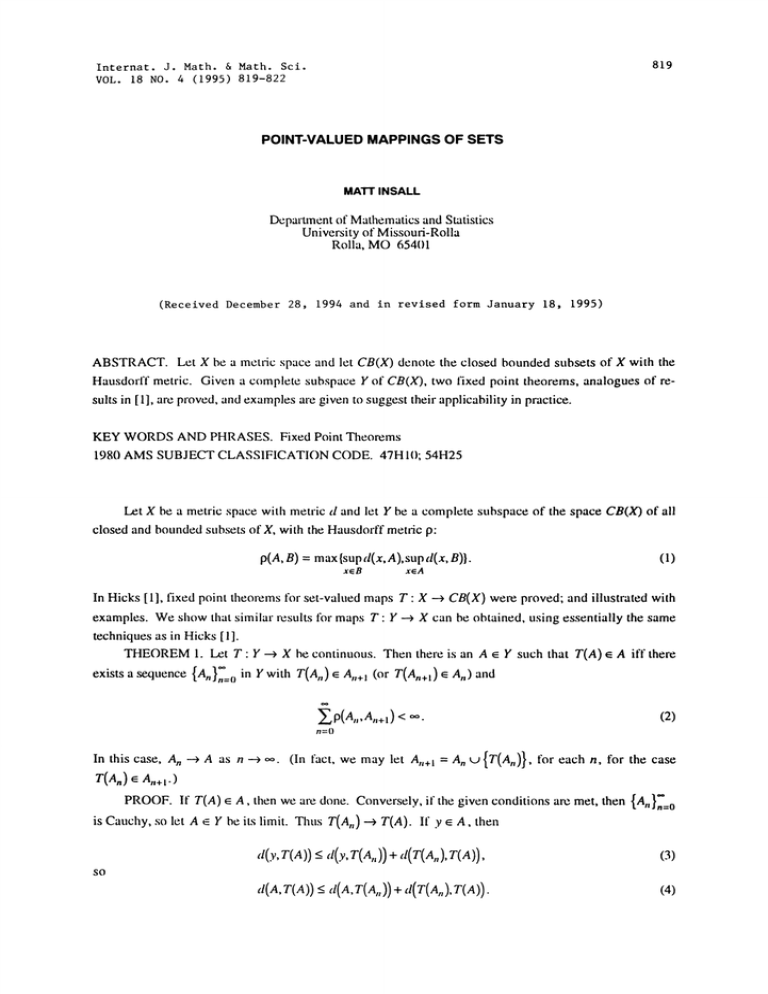
819
Internat. J. Math. & Math. Sci.
VOL. 18 NO. 4 (1995) 819-822
POINT-VALUED MAPPINGS OF SETS
MATT INSALL
Department of Mathematics and Statistics
University of Missouri-Rolla
Rolla, MO 654()1
(Received December 28, 1994 and in revised form January 18, 1995)
ABSTRACT. Let X be a metric space and let CB(X) denote the closed bounded subsets of X with the
Hausdorff metric. Given a complete subspace Y of CB(X), two fixed point theorems, analogues of results in 1], are proved, and examples are given to suggest their applicability in practice.
KEY WORDS AND PHRASES. Fixed Point Theorems
1980 AMS SUBJECT CLASSIFICATION CODE. 47H1(); 54H25
Let X be a metric space with metric d and let Y be a complete subspace of the space CB(X) of all
closed and bounded subsets of X, with the Hausdorff metric p:
p(A, B) max {supd(x,a),supd(x, B)}.
xeB
(1)
xeA
In Hicks 1], fixed point theorems for set-valued maps T X ---) CB(X) were proved; and illustrated with
examples. We show that similar results for maps T Y X can be obtained, using essentially the same
techniques as in Hicks ].
THEOREM 1. Let T Y --) X he continuous. Then there is an A Y such that
exists a sequence
in Y with T(A.) A,,+I (or T(A,,+I
A,,) and
T(A) A
iff there
{an}’=o
Ep(A,,,An+,) < o,,.
(2)
n=O
In this case, A
A as n
--)oo.
(In fact, we may let
A,,+,
A u {T(ACa)}, for each n, for the case
T(An) An+t.)
PROOF. It" T(A) A, then we are done. Conversely, if the given conditions are met, then
is Cauchy, so let A Y be its limit. Thus T(A,,) ---) T(A). If y A, then
{a,,}=o
d(y, T(A)) < d(y, T(A,, ))+ d(T(A ), T(A)),
(3)
d(A, T(A)) < d(A, T(A. )) + d(T(A ), T(A)).
(4)
SO
M. INSALL
820
Since
d(,T(A,),T(A)) --){1 and we have d( A, T( A,
EXAMPLES
(1) Let X
[11,1].
where cx
T(A) A.
I
CB(N)
- -
(6)
A
[(I, oo)
be such that r
[{I, oo)
a, where a is the identity on
eu-(lsup(A)l) + (1 a),’(linf(A)l),
(7)
({).1). Assuming ," is continuous, so is T. Let Ao CB(I), and for
An+l A,
Theorem
{T(A)}.
T(A)
by
T(A)
where a e
CB(R), then
Then T is continuous. If A
as in 1, and let r-
Define T"
(5)
ctsup(A) + (1 or) inf(A),
T(A {T(A)})
IR.
{1, it follows that
I, with the usual metric. Define T" CB(I) ---) R by
T(A)
(2) Let X
< p(A,A,+,)
yields A
n e IN, let
kg[inf{T(A,)},sup{T(At)}].
L
(8)
k<n"
k<-n"
C3(1) with T(A) A it"
inf T A )}A,
E max d k<n{
n=l
d,suPtT(Ak)j,A
(9)
kk<n
DEFINITION. Let (X,d) be a metric space and let Ybe a subspace of (CB(X),p). Let T" Y --> X.
Then T is nice if for each A Y and each x A with d(x,T(A)) d(A,T(A)), there exists a set B Y
with T(B) x.
EXAMPLES
[ defined by
(3) Let X [2, T.
CB([2)__>
T(A)
(inf(proj,(A)),sup(proj,(A))).
(10)
Then T(A)= ({},a), and ({},b) is the only point of A whose
equals
d(A,T(A)). Let B [0,b] Then T(B) (O,b).
({),a)
I 2, and for A e CB(N 2), let T(A) be the center of the circle which circumscribes A.
Let a > b and A
[{ }, al x [0, b]
distance from
(4) Let X
Let r
d(A,T(A)),
and let x
A with d(x,T(A))
r.
Let B
A t. x. di
T(B) x.
THEOREM 2. Let (X,d) be a metric space and let Y be a complete subspace of
member of which is compact. Let T Y ---) X be continuous. Assume that K [0,,,,,)
decreasing, K(0) 0, and
p(A, B)<_
a, ta))
Then
(CB(X),p), each
[0,,,,,) is non-
K(d(T(A),T(B)))
for A, B e Y. If Tis nice, then there is A e Y such that T(A) e A iff there exists Ao e Y for which
(11)
POINT-VALUED MAPPINGS OF SETS
821
E K"(d(&, TfA,,))) <
In this case. we can choose {A,,},=, such that T(A,,+,). A, and A -+ A.
PROOF. If T(A)A, then we are done. If AoY satisfies (*), let xlAo with
d(x,.r(Ao)) d(A,,.r(A,,)). Si,,ce ris nice. let At e Y with r(A,)= x,.
Next, let x A with d(x2,T(Al) d(AI,T(A,) ), and then let A
r with T{A=)= x:. Then
d(r(A, ), r(A= )) d(r(A, ).x=
d(T(A ). A d(x
A
(12)
<- p(Ao,A,)-< K(d(r<A,,>,r<A,))),
so that
K(d(T(A,),T(A))) <_ n=(d(T{A,,),T{A,)))
Now.
T(An)
x
K=(d(T(&,),&,)).
suppose we have x, A,,_ and A Y with d(x..r(A._,))= d(A._,.r(A._,)) ,
Let xn+ A with d(xn+l,T(An) d(a.,r(A.)) and let An+ r with T(An+I)= Xn+
1.
Then
d(r(a,,), T(A,,+I)) d(r(a,,),xn+ 2)
d(r(a,,).A.)
r{A.))).
so that
K(d(T(An),T(A,,+,)) < K2(d(T(An_t),T(An)))
K(K(d(T(A,,_,),T(A,,))))
< K(K2(d(T(A,,_2),T(An_,))))
(15)
K3(d(T(A,,_=),T(A,,_,)))
Thus, since
p(A,,. A,,+,
<
K(d(T(A,, ), T(An+ ))),
(16)
it follows from (*) that
]P(A,,,A,,+I) < ,
n=O
and then by Theorem 1,
A,, -+ A
and T(A)
E
A. I
(17)
M. INSALL
822
Note that the conditions oi" theorem 2 force T to be a bijection, l,a both of these theorems, we have
used completeness of the given subspace Y of CB(X) instead of completeness of X. In fact, in theorem 2,
since T is a bijection, we may trade completeness of Y back for completeness of X and use the second
theorem of Hicks
].
THEOREM 3. If (X,d) is a complete metric space and Y is any subspace of
member of which is compact, the,a for any homeomorphism T Y ---> X such that
p(a, B)< K(d(T(A ), T( B))),
where K
exists Ao
[(Loo) --> [0,0,,)
is nondecreasing, with K(0)
Y for which (*) holds.
PROOF. If Ao Y satisfies (*), let xo
obtain a p X such that p T-t(p). Let A
0, there is A
(CB(X),p), each
(18)
Y such that T(A) A iff there
Apply theorem 2 of Hicks [1] to T-l X --4 Y to
T-I(p). Then T(A) p is in A, so we are done. I
T(Ao).
REFERENCES
[1]
HICKS, T.L. Fixed-Point Theorems for Multivalued Mappings, Indian J. Pure Appl. Math.
20(11) (November 1989), 1(177-1(179





![5.5 The Haar basis is Unconditional in L [0, 1], 1 < 1](http://s2.studylib.net/store/data/010396305_1-450d5558097f626a0645448301e2bb4e-300x300.png)

